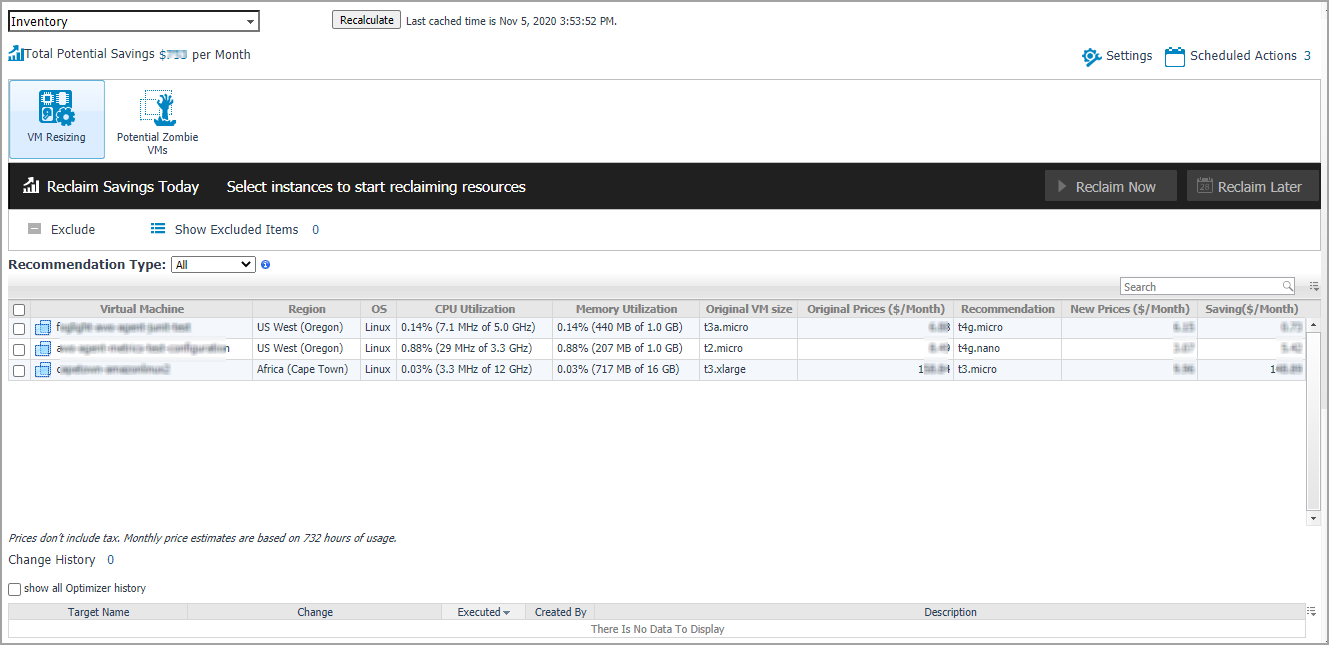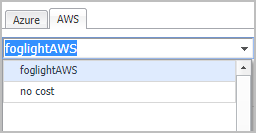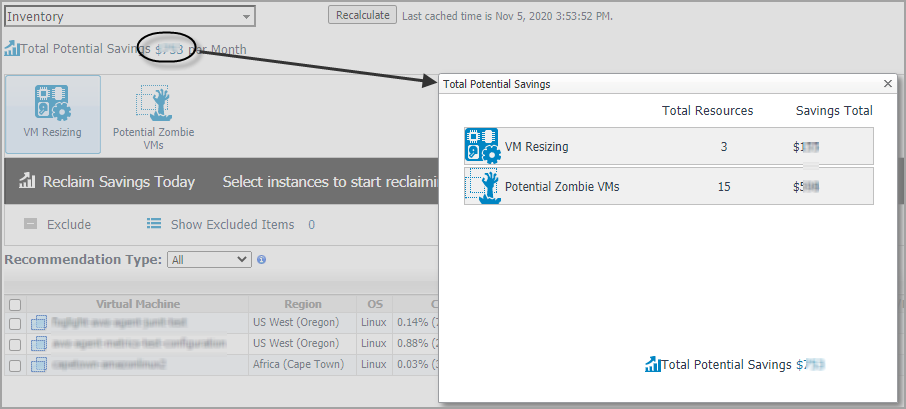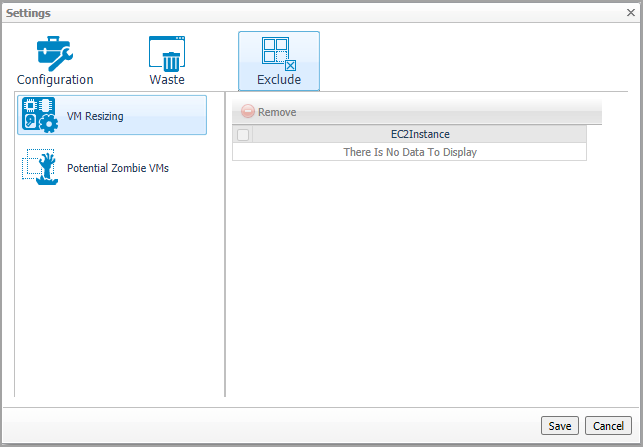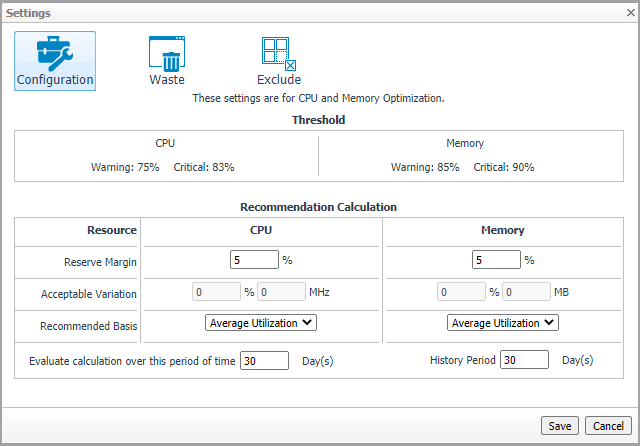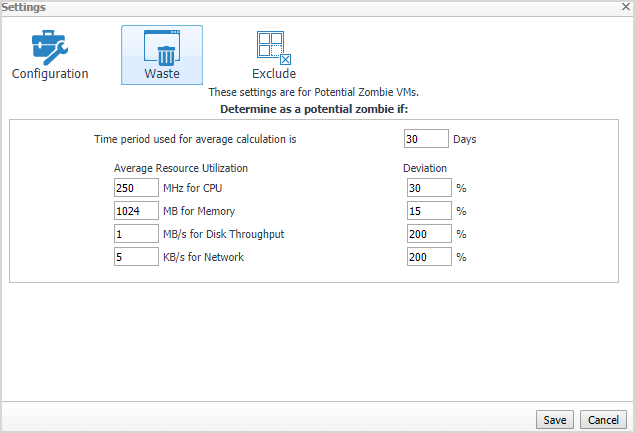Optimizer Tab
|
NOTE: If your FMS host doesn't have Internet connection, VM Resizing recommendations will not work properly. Ensure that the proxy is enabled and the settings are configured under Administration > Proxy Configuration. |
Click Optimizer on the top of the Cloud Manager dashboard to navigate to the Optimizer tab.
|
3 |
|
4 |
|
5 |
The Optimizer - AWS view includes the following elements:
|
• |
Group selector: The group selector is located at the top of the Optimizer - AWS view and allows you to select the AWS environment that you want to optimize. |
|
• |
Recalculate: Click the button to recalculate the data. Click Recalculate on the Recalculate Confirmation dialog box to start recalculating. |
|
• |
Total Potential Savings. Shows the potential savings per month. Click the savings and a Total Potential Savings dialog box opens. It displays the total resources and total savings for VM Resizing and Potential Zombie VMs. |
|
• |
Settings. The Settings dialog box is used to change the time period and properties that are used for calculation. For more information, see Settings. |
|
• |
Scheduled Actions. The Scheduled Actions dialog shows the list of operations scheduled to be run at a particular time in the future, and allows you to edit or remove any scheduled actions. To view only the actions specific to Foglight Resource Optimizer, select the show only Optimizer actions checkbox. When the checkbox is not selected, the dialog shows all actions scheduled for your virtual environment. |
|
• |
VM Resizing. Shows instance name, utilization, and recommendations for both CPU & memory resources. |
|
• |
Potential Zombie VMs. Shows instance name, regions, CPU, memory, disk throughput, and network of the zombie virtual machines based on calculation settings. |
|
• |
Reclaiming Savings bar. The Reclaiming Savings bar enables the system administrator to select instances from the list and review the resources that can be reclaimed. |
|
• |
Exclude. After selecting an instances either in the VM Resizing or Potential Zombie VMs instance table, click Exclude to remove the selected instances from calculation. |
|
NOTE: The Reclaim Now and Reclaim Later buttons and the Exclude link are enabled only after selecting an instance from the table. |
|
• |
Show Excluded Items. Click the Show Excluded Items button or Settings > Excluded tab to show the instances that have been excluded from calculation. |
|
• |
Recommendation Type: Include three options: All, Executable, and Inexecutable. Use to filter the resources that can be reclaimed or review the resources that cannot be reclaimed. |
|
• |
Change History view. The Change History embedded view shows the changes that have been implemented in the environment during the History Period [x] Day(s), the object that was affected, and the result of the operation. |
|
• |
Target Name. Virtual machine that was affected by the change. |
|
• |
Change. Type of change. |
|
• |
Executed. Date and time when the change was executed. |
|
• |
Created By. User who scheduled the change. |
|
• |
Description. Operation result: Completed, In progress, or Failed (and an explanation why the job has failed). |
Settings
Use the Settings menu to define the default optimization settings for your environment. The Settings Dialog box provides information about the following components:
Configuration tab
The Configuration tab provides the recommended settings for CPU and memory optimization.
|
• |
Thresholds. Provides the values of a resource metric that define the Warning and Critical levels (for CPU and memory). |
|
• |
Recommendation Calculation area. Allows you to define the following parameters for optimizing the CPU and memory resources in your environment: |
|
• |
Reserve Margin [x]%. This parameter is used for calculating the Evaluation Result, which is needed for making recommendations. The Recommendation Reserve Margin percentage is the percentage above the recommended basis, reserved for unexpected increases in utilization. |
|
• |
Acceptable Variation. Don't use at AWS resource calculation now. |
|
• |
Recommended Basis. Use this list to select the Recommended Basis to be used for calculating the Evaluation Result. Currently just support Average Utilization. |
|
• |
Evaluate calculation over this period of time [x] Day(s). Defines the time interval during which the right-sizing calculation is performed. |
|
• |
History Period [x] Day(s). The Change History view displays the changes for the time interval defined here. |
To save any changes made to the Configuration settings, click Save at the bottom of the tab.
Waste tab
The Waste tab allows you to configure the settings for determining resources wasted in your environment. These include powered-off instances, and potential zombie VMs:
|
• |
Determine as a potential zombie if area: A VM is considered a zombie VM if the following five settings are met: |
|
• |
Time period used for average calculation is [x] Days. Defines when a resource is considered a zombie VM, by looking at the period used for average calculations. |
|
• |
Average Resource Utilization-Deviation. Defines when a resource is considered a zombie VM, by looking at the CPU, memory, disk throughput, and network utilization values. |
To save any changes made to the Waste settings, click Save at the bottom of the tab.

